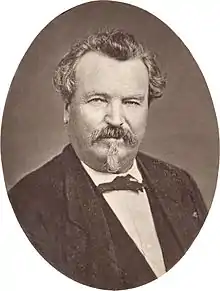Pierre Trémaux
Pierre Trémaux (20 July 1818 – 12 March 1895) was a French architect, Orientalist photographer, and author of numerous scientific and ethnographic publications.
Pierre Trémaux | |
|---|---|
 Portrait of Pierre Trémaux, 1866 | |
| Born | 20 July, 1818 Charrecey, France |
| Died | 12 March, 1895 Tournus, France |
| Nationality | French |
| Education | École des Beaux-Arts |
| Known for | Architect, illustrator, author and photographer |
| Movement | Orientalist |
| Awards | Chevalier, Légion of Honour; Prix de Rome |
Life and career
Very little is known about Pierre Trémaux's life. He was born in Charrecey, France into a family of modest means. He was the son of Jean-Marie Trémaux, a farmer and Claudine Renaudin and had at least two sisters. Details of his final years are very sketchy and details of death and final resting place are unknown. [1]
Trémaux distinguished himself in many fields. He entered the École des Beaux-Arts in 1840 and received the second Prix de Rome in Architecture in 1845. As a trained architect, he worked at the Schneider establishments in Le Creusot. He was interested in urbanism, the breakthrough of the Suez Canal. A naturalist, he traveled to Algeria, Tunisia, Upper Egypt, Eastern Sudan and Ethiopia in 1847-1848, where he made many drawings and became one of the first to produce photographic images of the region.[2] From Alexandria, he went up the Nile to Nubia. In 1853-1854, he undertook a second photographic trip to Libya, Egypt, Asia Minor, Tunisia, Syria and Greece. He returned from these trips with many illustrations and photographic images, some of the first photographs ever made of the region and its people.
Work

Photography
Relatively few of his photographs have survived, and of the few that exist, the condition is very poor yet these reveal that he was not particularly talented as a photographer. However, his published works, the Voyagesseries, were the first books on Egypt, Palestine and other Middle Eastern locations to use photographic illustrations. [3]
Theory of Evolution
Trémaux is the author of a work that caused a sensation at the 1867 Universal Exhibition in Paris: Origine et transformations de l'homme et des autres êtres (translated as Origin and Transformations of Man and Other Beings), 1865. In this book he proposed, for the first time in history, the evolutionary theory that today is referred to as the theory of punctuated equilibria.[4]
Publications
Between 1852 and 1868, Trémaux produced a number of distinct groups of photographic plates to accompany texts on the geography, architecture, and people of African and Anatolian regions. Produced with the support of French government, these high quality publications, combined an array of graphic techniques in ways that had not previously been attempted. The images combine salted paper prints, engravings, tinted and colour lithographs and photolithographs. [5]
Articles
- "Notice d’un voyage sur le cours du Nil et dans des parties inconnues du Soudan, chez les nègres Bertha, du Darfok et du Dar-Gourum," Bulletin de la Société de Géographie, 1849, sèr., 12 pp 67-72
- "Notes sur la localité ou sont situées les principales mines d’or du Soudan oriental, et observations critiques sur le récit du Colonel Kovalevski relatif à cette même contrée." Bulletin de la Société de Géographie, 1850, sér. 13 (73-78)
- "Quelques détails sur les prétendus hommes à queue," Bulletin de la Société de Géographie, 1855, 4e sér., 9 (49-54), p. 139-148
- "Épisode d’un voyage au Soudan oriental et remarques sur l’esclavage," Bulletin de la Société de Géographie, 1856, 4e sér., 11 (61-66), p. 153-164
- "Remarques sur l’Afrique centrale et orientale," Bulletin de la Société de Géographie, 1862, 5e sér., 3 (13-18), p. 69-86 et 147-165
Books
- Parallèle des édifices anciens et modernes du continent africain, illustré de 82 planches et une carte de l'Afrique Centrale, 1858
- Dessinés et relevés de 1847 à 1854 dans l'Algerie, les régences de Tunis et de Tripoli, l'Égypte, la Nubie, les déserts, l'île de Méroé, le Sennar, le Fa-Zogle, etc.
- Exploration archéologique en Asie mineure, illustré de 92 planches, 1864
- Voyage en Éthiopie, au Soudan Oriental et dans la Nigritie, atlas illustré de 61 planches, Hachette, 1852
- Voyage en Éthiopie, au Soudan Oriental et dans la Nigritie, Vol 1: Égypte et Éthiopie, textes de l'Atlas, Hachette, 1862
- Voyage en Éthiopie, au Soudan Oriental et dans la Nigritie, Vol. 2: Le Soudan, textes de l'Atlas, Hachette, 1862.
- Origine et transformations de l'homme et des autres êtres, Hachette, 1865
- Principe universel de la vie, de tout mouvement et de l'état de la matière, Chez l'auteur, 1868, 1874, 1876
- Origine des espèces et de l'homme avec les causes de fixité et de transformation et principe universel du mouvement et de la vie ou loi des transmissions de force, 1898
See also
References
- Hannavy, J., Encyclopedia of Nineteenth-Century Photography, Routledge, 2013, p. 477
- Merli, A., "A New Art in an Ancient Land: Palestine through the Lens of Early European Photographers," Jerusalem Quarterly, Vol. 50, Summer 2012
- Hannavy, J., Encyclopedia of Nineteenth-Century Photography, Routledge, 2013, p. 477
- Wilkins, John S. and Nelson, Gareth J., "Trémaux on Species: A theory of allopatric speciation (and punctuated equilibrium) before Wagner", Archives of Philosophy of the Science, University of Pittsburgh, 2008; texte repris dans la revue History and Philosophy of the Life Sciences, 2008, 30, pp 179-206
- Addleman-Frankel, K., "The Experience of Elsewhere: Photography in the Travelogues of Pierre Trémaux," Photographies, Vol. 11, No. 1, 2018, pp 31-56, DOI: https://doi.org/10.1080/17540763.2017.1399287
This article includes material translated from the French Wikipedia, fr:Pierre Trémaux
| Wikimedia Commons has media related to Pierre Trémaux. |
External links
- Origine et transformations de l'homme et des autres êtres (Hachette, 1865) available on Google books